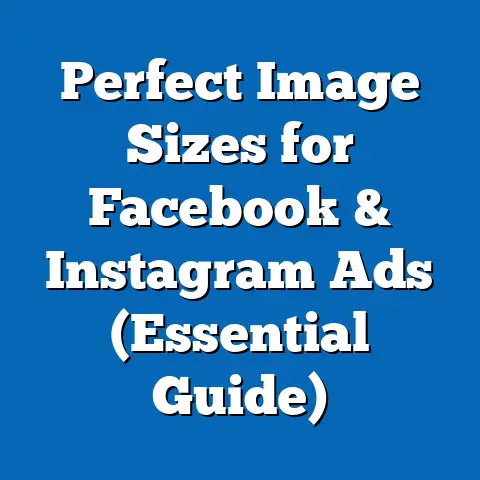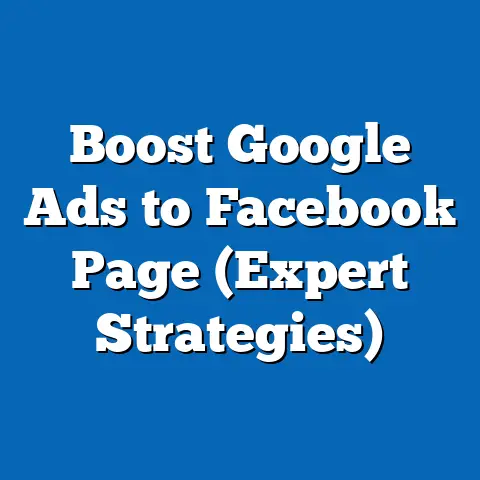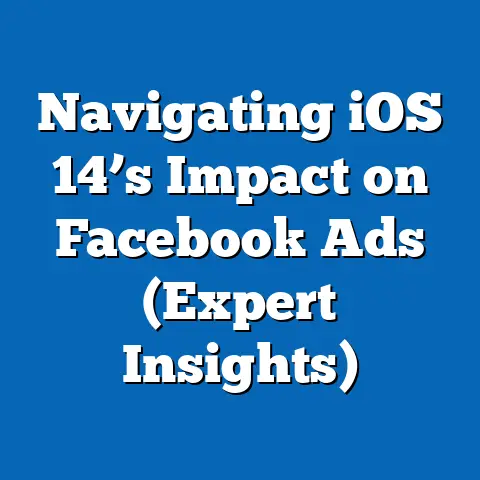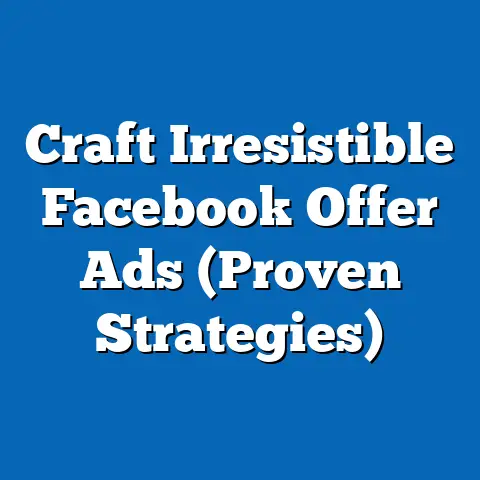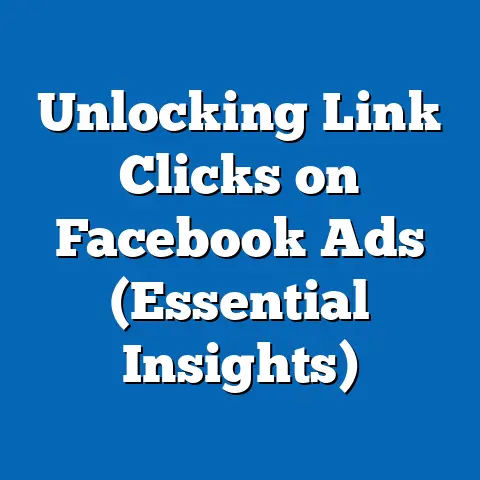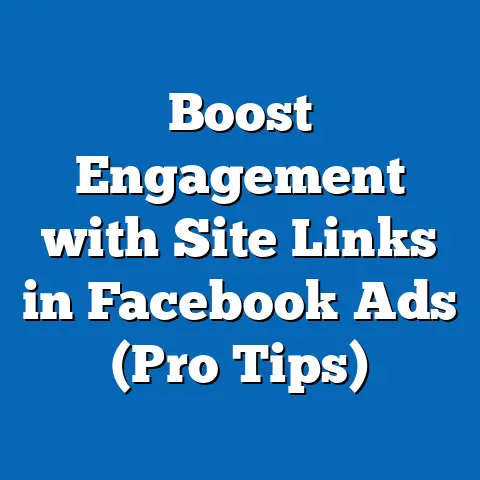Cut Facebook Ads: Proven Strategies (Expert Tips)
In the ever-evolving world of digital marketing, the health of your business often hinges on the effectiveness of your advertising strategies. And let’s face it, in today’s digital landscape, Facebook advertising isn’t just an option; it’s practically a necessity. But what happens when those ads, instead of driving growth, become a source of stress, frustration, and financial strain? I’ve been there, staring at underperforming campaigns, feeling the weight of wasted ad spend crushing my spirits. It’s a feeling I wouldn’t wish on anyone.
The truth is, ineffective advertising, especially on a platform as vast and complex as Facebook, can have a significant impact on your business health – and, more importantly, your personal well-being. The financial stress of wasted ad spend, the mental burden of constantly tweaking campaigns that just aren’t working, and the feeling of being lost in a sea of data can take a serious toll.
That’s why mastering Facebook Ads isn’t just about driving sales; it’s about creating a healthier, more sustainable business. When you know how to craft effective campaigns, you reduce anxiety, improve your work-life balance, and create a sense of control over your business’s destiny.
Consider this: Facebook boasts over 2.9 billion monthly active users (Statista, 2023). That’s an incredible audience pool, but reaching the right people with the right message requires skill and strategy. According to recent reports, global digital ad spending is projected to reach over $600 billion by the end of 2023 (eMarketer, 2023), and Facebook remains a dominant player in this space. This means businesses are investing heavily in Facebook Ads, and you need to ensure your investment is paying off.
Section 1: Understanding Facebook Ads
Before we dive into the nitty-gritty strategies, it’s crucial to have a solid foundation of understanding regarding what Facebook Ads are and how they work. Think of it as knowing the rules of the game before you step onto the field.
What are Facebook Ads?
Facebook Ads are paid advertisements that businesses use to reach their target audience on Facebook and its associated platforms, including Instagram, Messenger, and the Audience Network. They are a powerful tool for businesses of all sizes, allowing you to connect with potential customers based on their demographics, interests, behaviors, and more.
Unlike organic posts, which are only seen by your followers and their networks, Facebook Ads allow you to reach a much wider audience, including people who have never heard of your business before. This makes them an invaluable tool for brand awareness, lead generation, and driving sales.
Here’s a breakdown of some of the most common types of Facebook Ads:
- Image Ads: These are simple ads that feature a single image and accompanying text. They’re great for showcasing products, promoting events, or driving traffic to your website. I’ve found that using high-quality, visually appealing images is key to capturing attention in the crowded newsfeed.
- Video Ads: Video ads are more engaging than image ads and can be used to tell a story, demonstrate a product, or share a testimonial. They’re particularly effective for capturing attention and driving conversions. I’ve personally seen video ads generate significantly higher engagement rates compared to static images.
- Carousel Ads: Carousel ads allow you to showcase multiple images or videos in a single ad unit. This is a great option for highlighting different products, showcasing a product’s features, or telling a story in a sequential format. I’ve used carousel ads to showcase different angles and features of a product, resulting in a noticeable increase in click-through rates.
- Collection Ads: Collection ads are designed for mobile devices and allow users to browse and purchase products directly from the ad. They’re ideal for e-commerce businesses looking to drive sales on mobile. I’ve seen e-commerce clients experience a substantial boost in mobile conversions using collection ads.
- Lead Ads: Lead ads are designed to collect leads directly from Facebook. They feature a pre-populated form that users can fill out with just a few taps. This makes it easy for businesses to generate leads without sending users to a landing page. I’ve found lead ads to be incredibly effective for generating qualified leads for service-based businesses.
- Instant Experience Ads: These ads offer a full-screen, interactive experience that loads instantly when someone clicks on your ad. They’re great for telling a brand story, showcasing a product, or creating an engaging experience for users. I’ve used Instant Experience ads to create immersive brand experiences, resulting in increased brand awareness and engagement.
Choosing the right ad type depends on your specific goals and target audience. Experiment with different formats to see what works best for your business.
The Mechanics of Facebook Ads
Understanding how Facebook Ads work is crucial for creating effective campaigns. The platform uses a complex auction system to determine which ads are shown to which users. This system considers several factors, including your bid amount, ad quality, and estimated action rates.
Here’s a breakdown of the key components of the Facebook Ads system:
- The Auction: Facebook Ads operate on an auction system. Advertisers bid against each other to have their ads shown to specific users. The higher your bid, the more likely your ad is to be shown. However, bid amount isn’t the only factor.
- Ad Quality: Facebook prioritizes ads that are relevant and engaging to users. Your ad quality score is based on factors like user feedback, click-through rates, and landing page experience. A high-quality ad can win the auction even with a lower bid. I’ve consistently seen that focusing on creating high-quality, relevant ads leads to lower costs and better results.
- Estimated Action Rates: Facebook also considers the likelihood that a user will take a desired action, such as clicking on your ad, liking your page, or making a purchase. The higher your estimated action rate, the more likely your ad is to be shown.
- Targeting Options: Facebook offers a wide range of targeting options, allowing you to reach specific audiences based on their demographics, interests, behaviors, and more. This is one of the most powerful features of Facebook Ads, allowing you to laser-focus your advertising efforts.
- Ad Placements: You can choose where your ads are shown on Facebook and its associated platforms. Common placements include the Facebook News Feed, Instagram Feed, Audience Network, and Messenger. Different placements can have different costs and performance metrics.
Navigating the Facebook Ads Manager
The Facebook Ads Manager is your central hub for creating, managing, and analyzing your Facebook Ads. It’s a powerful tool, but it can also be overwhelming at first.
Here’s a brief overview of the key functionalities of the Ads Manager:
- Campaigns: Campaigns are the overarching structure for your advertising efforts. You set your campaign objective, budget, and bidding strategy at the campaign level.
- Ad Sets: Ad sets define your target audience, ad placements, and schedule. You can create multiple ad sets within a single campaign to target different audiences or test different placements.
- Ads: Ads are the individual advertisements that you create. You define the ad copy, visuals, and call-to-action at the ad level.
- Reporting: The Ads Manager provides detailed reports on your ad performance, including metrics like impressions, clicks, conversions, and cost-per-result. This data is crucial for optimizing your campaigns.
Key Takeaway: Understanding the mechanics of Facebook Ads and navigating the Ads Manager are essential for creating effective campaigns. Don’t be afraid to experiment and test different strategies to see what works best for your business.
Next Steps: Familiarize yourself with the Facebook Ads Manager interface and explore the different targeting options and ad placements available.
Section 2: Setting Clear Goals
Imagine embarking on a road trip without a destination in mind. You’d likely wander aimlessly, wasting time and fuel. The same principle applies to Facebook Ads. Without clear goals, you’re essentially throwing money at the platform and hoping for the best. And trust me, that’s a recipe for frustration and wasted ad spend.
Defining Objectives
Setting clear, measurable goals is the foundation of any successful Facebook Ads campaign. Your goals should be specific, measurable, achievable, relevant, and time-bound (SMART). This means they should be clearly defined, quantifiable, attainable, aligned with your overall business objectives, and have a specific deadline.
Here are some common advertising objectives that businesses use on Facebook:
- Brand Awareness: The goal is to increase awareness of your brand among your target audience. This objective is ideal for new businesses or those launching new products or services. I’ve used brand awareness campaigns to introduce new brands to the market, focusing on reaching a broad audience with engaging content.
- Reach: The goal is to show your ad to the maximum number of people within your target audience. This is similar to brand awareness but focuses on maximizing reach rather than engagement.
- Traffic: The goal is to drive traffic to your website or landing page. This objective is ideal for businesses looking to generate leads or drive sales on their website. I’ve found that traffic campaigns are particularly effective when targeting users who are already familiar with your brand.
- Engagement: The goal is to increase engagement with your Facebook page or posts. This includes metrics like likes, comments, shares, and video views. This objective is ideal for building a community around your brand.
- Lead Generation: The goal is to collect leads from potential customers. This objective is ideal for businesses looking to build their email list or generate qualified leads for their sales team. I’ve used lead generation campaigns to collect leads for webinars, free trials, and other valuable offers.
- App Installs: The goal is to drive installs of your mobile app. This objective is ideal for businesses that have a mobile app and want to increase its user base.
- Video Views: The goal is to increase the number of views on your video ads. This objective is ideal for businesses looking to build brand awareness or generate leads through video content.
- Conversions: The goal is to drive specific actions on your website, such as purchases, sign-ups, or form submissions. This objective is ideal for e-commerce businesses and those looking to generate qualified leads. I’ve consistently seen that conversion campaigns, when properly optimized, deliver the highest ROI.
- Sales: The goal is to drive sales of your products or services. This objective is ideal for e-commerce businesses looking to increase their revenue.
- Store Traffic: The goal is to drive traffic to your physical store location. This objective is ideal for businesses with brick-and-mortar stores looking to increase foot traffic.
Examples of SMART Goals:
- Instead of: “Increase brand awareness.”
- Try: “Increase brand awareness by 20% among women aged 25-34 in the United States within the next three months.”
- Instead of: “Drive more traffic to my website.”
- Try: “Drive 500 new visitors to my website per week from Facebook Ads within the next month.”
- Instead of: “Generate more leads.”
- Try: “Generate 100 qualified leads per month from Facebook Ads at a cost of no more than $10 per lead.”
Aligning Goals with Health Benefits
This is where things get interesting. How can setting clear goals actually benefit your health and well-being? The connection might not be immediately obvious, but trust me, it’s there.
- Reduced Stress: When you have clear goals, you know what you’re working towards and how to measure your progress. This reduces the anxiety and uncertainty that comes with aimless advertising. I’ve personally experienced a significant reduction in stress levels when I have a well-defined plan in place.
- Increased Focus: Clear goals help you prioritize your efforts and avoid distractions. This allows you to focus on the tasks that are most important for achieving your objectives.
- Improved Confidence: Achieving your goals, even small ones, boosts your confidence and motivates you to keep going. This creates a positive feedback loop that can lead to greater success and overall well-being.
- Better Work-Life Balance: When you’re not constantly stressed and overwhelmed by your advertising efforts, you have more time and energy to focus on other aspects of your life. This can lead to a better work-life balance and improved overall happiness.
Case Study:
I worked with a small e-commerce business that was struggling with their Facebook Ads. They were spending a lot of money on ads, but they weren’t seeing the results they wanted. They were stressed, frustrated, and on the verge of giving up.
The first thing we did was to define clear, measurable goals. We decided to focus on driving sales of their most popular product. We set a goal of increasing sales by 20% within the next month.
We then optimized their Facebook Ads to target their ideal customer and crafted compelling ad copy and visuals. We also implemented a robust tracking system to monitor their progress.
Within a few weeks, they started to see significant results. Their sales increased by 25%, exceeding their initial goal. They were thrilled with the results, and their stress levels plummeted. They had a clear plan, they were seeing progress, and they were feeling more confident than ever before.
Key Takeaway: Setting clear, measurable goals is not only essential for successful Facebook Ads campaigns, but it can also have a significant positive impact on your health and well-being.
Next Steps: Define SMART goals for your Facebook Ads campaigns and track your progress regularly. Celebrate your successes and learn from your failures.
Section 3: Crafting Compelling Ad Copy and Visuals
Now that you have your goals in place, it’s time to focus on the creative aspects of your Facebook Ads: the ad copy and visuals. These are the elements that will capture your audience’s attention and persuade them to take action. Think of it as crafting the perfect invitation to your party – you want it to be irresistible!
The Art of Persuasive Copywriting
Compelling ad copy is essential for driving engagement and conversions. Your copy should be clear, concise, and relevant to your target audience. It should also highlight the benefits of your product or service and include a strong call-to-action.
Here are some expert tips on writing persuasive ad copy:
- Know Your Audience: Understand their needs, wants, and pain points. Tailor your copy to address their specific concerns. I always start by creating detailed buyer personas to understand my audience inside and out.
- Highlight Benefits, Not Just Features: Focus on how your product or service will improve their lives. People are more interested in the benefits than the technical features. For example, instead of saying “Our software has advanced analytics,” say “Gain valuable insights into your business performance with our easy-to-use analytics dashboard.”
- Use Emotional Appeal: Connect with your audience on an emotional level. Use language that evokes feelings of excitement, happiness, or even fear (if appropriate). I’ve found that ads that tap into emotions tend to perform better than those that rely solely on logic.
- Keep it Short and Sweet: People have short attention spans, especially on social media. Get to the point quickly and avoid using jargon or overly complex language.
- Use Strong Call-to-Actions: Tell people exactly what you want them to do. Use action-oriented verbs like “Shop Now,” “Learn More,” “Sign Up,” or “Get Started.” I’ve tested different call-to-actions and found that specific, compelling CTAs consistently outperform generic ones.
- Use Numbers and Statistics: Numbers and statistics can add credibility to your claims and make your copy more persuasive. For example, “Join over 10,000 satisfied customers” or “Get 50% off your first order.”
- Test Different Headlines: The headline is the first thing people will see, so it’s crucial to make it attention-grabbing. Test different headlines to see which ones perform best. I often run A/B tests with different headlines to optimize for click-through rates.
Health-Related Messaging in Copy:
If your product or service is related to health or well-being, it’s important to incorporate health-related messaging into your copy. This can include highlighting the health benefits of your product, addressing health concerns, or promoting a healthy lifestyle.
For example, if you’re selling a fitness app, you could highlight the health benefits of regular exercise, such as improved cardiovascular health, weight loss, and stress reduction. You could also address common health concerns, such as lack of motivation or time constraints.
Visual Elements that Capture Attention
In the visually driven world of Facebook, your ad visuals are just as important as your ad copy. High-quality visuals can capture attention, convey your message, and drive engagement.
Here are some tips on creating eye-catching images and videos:
- Use High-Quality Images: Avoid using blurry or pixelated images. Use professional-quality images that are well-lit and visually appealing. I always invest in professional photography or use high-quality stock photos to ensure my ads look their best.
- Use Bright Colors: Bright colors can help your ad stand out in the crowded newsfeed. Use colors that are consistent with your brand and that appeal to your target audience.
- Use Visual Hierarchy: Use visual hierarchy to guide the viewer’s eye to the most important elements of your ad. This can include using different font sizes, colors, and placements.
- Show People Using Your Product: People are more likely to be interested in your product if they can see others using it. Use images or videos that show people enjoying your product or service.
- Use Movement: Videos and animated GIFs are more engaging than static images. Use movement to capture attention and tell a story. I’ve found that short, engaging videos are particularly effective for capturing attention on Facebook.
- Maintain Brand Consistency: Your ad visuals should be consistent with your brand identity. This includes using the same colors, fonts, and logo.
- A/B Test Your Visuals: Don’t be afraid to experiment with different visuals to see what works best. Test different images, videos, and layouts to optimize for engagement and conversions.
Aligning Visuals with Health Benefits:
Just like with your ad copy, it’s important to align your visuals with health benefits if your product or service is related to health or well-being. This can include using images of healthy people, showing the positive effects of your product, or promoting a healthy lifestyle.
For example, if you’re selling a healthy snack, you could use images of people enjoying your snack while engaging in healthy activities, such as hiking or yoga. You could also show the nutritional benefits of your snack, such as its high fiber content or low sugar content.
Key Takeaway: Crafting compelling ad copy and visuals is essential for capturing attention, driving engagement, and achieving your advertising goals.
Next Steps: Review your existing Facebook Ads and evaluate the effectiveness of your ad copy and visuals. Experiment with different approaches to see what resonates best with your target audience.
Section 4: Targeting the Right Audience
You could have the most compelling ad copy and stunning visuals, but if you’re showing your ads to the wrong people, you’re essentially shouting into the void. Targeting the right audience is crucial for maximizing the effectiveness of your Facebook Ads and achieving your goals. Think of it as inviting the right guests to your party – the ones who are most likely to enjoy themselves and stick around.
Understanding Your Audience
Before you can target the right audience, you need to understand who they are. This involves conducting thorough audience research and segmentation.
Here are some key questions to ask yourself about your target audience:
- Who are they? What are their demographics (age, gender, location, education, income)?
- What are their interests? What are their hobbies, passions, and interests?
- What are their behaviors? What are their online and offline behaviors?
- What are their pain points? What are their challenges and frustrations?
- What are their goals? What are they trying to achieve?
Facebook offers a wide range of targeting options, allowing you to reach specific audiences based on their demographics, interests, behaviors, and more.
Here are some of the most common targeting options:
- Demographics: Target users based on their age, gender, location, education, income, relationship status, and more. I often use demographic targeting to narrow down my audience and focus on those who are most likely to be interested in my product or service.
- Interests: Target users based on their interests, hobbies, and passions. Facebook gathers this information from users’ profiles, pages they like, and content they engage with. This is a powerful way to reach people who are already interested in your niche.
- Behaviors: Target users based on their online and offline behaviors, such as their purchase history, travel habits, and device usage. This is a more advanced targeting option that can be incredibly effective for reaching specific audiences.
- Custom Audiences: Create custom audiences based on your existing customer data, such as email lists, website visitors, and app users. This allows you to retarget users who have already interacted with your business. I’ve found custom audiences to be extremely effective for driving conversions and increasing customer loyalty.
- Lookalike Audiences: Create lookalike audiences based on your custom audiences. Facebook will identify users who share similar characteristics to your existing customers, allowing you to reach new potential customers who are likely to be interested in your product or service. Lookalike audiences are one of my go-to strategies for expanding my reach and finding new customers.
- Saved Audiences: You can also create saved audiences by combining different targeting options. This allows you to create highly specific audiences that are tailored to your unique business needs.
Creating Buyer Personas
Creating detailed buyer personas is a powerful way to enhance your targeting strategies. A buyer persona is a semi-fictional representation of your ideal customer, based on research and data about your existing customers and target audience.
Here are some key elements to include in your buyer personas:
- Name: Give your persona a name to make them more relatable.
- Demographics: Include their age, gender, location, education, income, and family status.
- Occupation: What is their job title and industry?
- Goals: What are they trying to achieve?
- Challenges: What are their pain points and frustrations?
- Values: What is important to them?
- Motivations: What motivates them to make a purchase?
- Favorite Brands: What brands do they admire and trust?
- Online Behavior: Where do they spend their time online? What websites and social media platforms do they use?
- Quote: Create a quote that sums up their personality and values.
Example Buyer Persona:
Name: Sarah Miller
Age: 35
Gender: Female
Location: San Francisco, CA
Occupation: Marketing Manager
Goals: To improve her marketing skills and advance her career.
Challenges: Staying up-to-date with the latest marketing trends and technologies.
Values: Creativity, innovation, and continuous learning.
Motivations: Recognition and career advancement.
Favorite Brands: HubSpot, Neil Patel, and Social Media Examiner.
Online Behavior: Spends time on LinkedIn, Twitter, and marketing blogs.
Quote: “I’m always looking for new ways to improve my marketing skills and stay ahead of the curve.”
By creating detailed buyer personas, you can gain a deeper understanding of your target audience and tailor your Facebook Ads to their specific needs and interests.
Benefits of Precise Targeting:
- Increased Relevance: When you target the right audience, your ads are more relevant to them, which leads to higher engagement rates.
- Lower Costs: Precise targeting allows you to reach the people who are most likely to be interested in your product or service, which reduces wasted ad spend.
- Higher Conversion Rates: When you show your ads to the right people, they are more likely to convert into customers.
- Improved ROI: By increasing relevance, lowering costs, and increasing conversion rates, precise targeting can significantly improve your ROI.
- Healthier Marketing Outcomes: When your advertising efforts are effective, you’ll experience less stress and more success, leading to healthier marketing outcomes.
Key Takeaway: Targeting the right audience is crucial for maximizing the effectiveness of your Facebook Ads and achieving your goals. Conduct thorough audience research, create detailed buyer personas, and use Facebook’s targeting options to reach the people who are most likely to be interested in your product or service.
Next Steps: Review your existing Facebook Ads and evaluate the effectiveness of your targeting strategies. Refine your targeting based on your audience research and buyer personas.
Section 5: Budgeting and Bidding Strategies
Now that you understand how to create compelling ads and target the right audience, it’s time to talk about money. Budgeting and bidding strategies are crucial for maximizing your ROI and ensuring that your Facebook Ads are cost-effective. Think of it as managing your party budget – you want to make sure you’re spending wisely and getting the most bang for your buck.
Setting a Realistic Budget
Setting a realistic budget is essential for achieving your advertising goals without breaking the bank. Your budget should align with your business goals and health considerations.
Here are some factors to consider when setting your budget:
- Your Business Goals: What are you trying to achieve with your Facebook Ads? Are you trying to increase brand awareness, generate leads, or drive sales? Your budget should align with your goals.
- Your Target Audience: How large is your target audience? The larger your audience, the more you’ll need to spend to reach them.
- Your Industry: What is the average cost-per-click (CPC) or cost-per-thousand impressions (CPM) in your industry? This will give you a benchmark for setting your budget.
- Your Campaign Duration: How long will your campaign run? Your budget should be sufficient to cover the duration of your campaign.
- Your Bidding Strategy: What bidding strategy are you using? Different bidding strategies have different costs.
- Your Health Considerations: How much stress are you willing to tolerate? Don’t overspend and put yourself in a financially precarious situation.
Budgeting Options:
Facebook offers two main budgeting options:
- Daily Budget: A daily budget sets the average amount you’re willing to spend each day. Facebook will try to spend this amount each day, but it may spend slightly more or less depending on the performance of your ads. I often use daily budgets for ongoing campaigns that I want to run consistently.
- Lifetime Budget: A lifetime budget sets the total amount you’re willing to spend over the entire duration of your campaign. Facebook will try to distribute your budget evenly over the campaign duration. I typically use lifetime budgets for campaigns with a specific end date, such as a promotion or event.
Tips for Setting a Realistic Budget:
- Start Small: If you’re new to Facebook Ads, start with a small budget and gradually increase it as you see results.
- Track Your ROI: Monitor your ROI closely to see how your ads are performing. Adjust your budget accordingly.
- Don’t Be Afraid to Experiment: Test different budgets to see what works best for your business.
- Prioritize Your Health: Don’t overspend and put yourself in a financially stressful situation.
Effective Bidding Strategies
Bidding strategies determine how Facebook bids for ad placements on your behalf. Choosing the right bidding strategy is crucial for maximizing your ROI.
Facebook offers several bidding strategies, including:
- Lowest Cost: Facebook will try to get you the most results for your budget, regardless of the cost per result. This is a good option for beginners or those who are focused on maximizing volume. I often use the lowest cost bidding strategy for brand awareness campaigns.
- Cost Per Result Goal: Set a target cost per result, and Facebook will try to achieve that goal. This is a good option for those who have a specific cost per result in mind.
- Highest Value: Facebook will focus on getting you the highest value conversions, such as purchases with a high order value. This is a good option for e-commerce businesses.
- Target Cost: Set a target cost per result, and Facebook will try to achieve that goal while staying within your budget. This is similar to the cost per result goal, but it gives you more control over your budget.
- Manual Bidding: You can also set your bids manually. This gives you the most control over your bidding strategy, but it requires more expertise and monitoring.
Tips for Choosing the Right Bidding Strategy:
- Consider Your Goals: What are you trying to achieve with your Facebook Ads? Your bidding strategy should align with your goals.
- Test Different Strategies: Experiment with different bidding strategies to see what works best for your business.
- Monitor Your Results: Monitor your results closely to see how your bidding strategy is performing. Adjust your strategy accordingly.
- Stay Up-to-Date: Facebook is constantly changing its bidding strategies, so stay up-to-date on the latest best practices.
Examples of Successful Budget Optimization:
I worked with a local restaurant that wanted to increase their online orders. They had a limited budget, so we needed to be strategic about how we spent their money.
We started by defining their target audience and creating compelling ad copy and visuals. We then used the lowest cost bidding strategy to maximize the number of people we reached.
We closely monitored their results and made adjustments to their budget and targeting as needed. Within a few weeks, they saw a significant increase in online orders, and their ROI improved dramatically.
Key Takeaway: Setting a realistic budget and choosing the right bidding strategy are crucial for maximizing your ROI and ensuring that your Facebook Ads are cost-effective.
Next Steps: Review your existing Facebook Ads and evaluate the effectiveness of your budgeting and bidding strategies. Experiment with different approaches to see what resonates best with your target audience.
Section 6: Analyzing and Optimizing Ads
Congratulations! You’ve set clear goals, crafted compelling ads, targeted the right audience, and set a realistic budget. But your work isn’t done yet. Analyzing and optimizing your ads is an ongoing process that’s essential for maximizing your ROI and achieving your advertising goals. Think of it as constantly tweaking your party playlist to keep the energy high and the guests engaged.
The Importance of Analytics
Analytics provide valuable insights into your ad performance, allowing you to identify what’s working and what’s not. By tracking and analyzing your data, you can make informed decisions about how to optimize your ads for better results.
Facebook offers a variety of tools for tracking and analyzing your ad performance, including:
- Facebook Ads Manager: The Ads Manager provides detailed reports on your ad performance, including metrics like impressions, clicks, conversions, and cost-per-result.
- Facebook Pixel: The Facebook Pixel is a piece of code that you install on your website. It allows you to track the actions that people take on your website after clicking on your Facebook Ad, such as purchases, sign-ups, and form submissions.
- Google Analytics: Google Analytics is a web analytics tool that provides detailed insights into your website traffic and user behavior. You can integrate Google Analytics with Facebook Ads to track the performance of your campaigns.
Key Performance Indicators (KPIs):
Here are some key performance indicators (KPIs) that marketers should focus on:
- Impressions: The number of times your ad was shown.
- Reach: The number of unique people who saw your ad.
- Clicks: The number of times people clicked on your ad.
- Click-Through Rate (CTR): The percentage of people who clicked on your ad after seeing it.
- Cost-Per-Click (CPC): The average cost you paid for each click on your ad.
- Conversions: The number of people who took a desired action after clicking on your ad, such as making a purchase or signing up for a newsletter.
- Cost-Per-Conversion (CPC): The average cost you paid for each conversion.
- Return on Ad Spend (ROAS): The amount of revenue you generated for every dollar you spent on advertising.
Tips for Analyzing Your Data:
- Track Your KPIs Regularly: Monitor your KPIs on a regular basis to see how your ads are performing.
- Identify Trends: Look for trends in your data to see what’s working and what’s not.
- Segment Your Data: Segment your data to see how different audiences are responding to your ads.
- Use A/B Testing: Use A/B testing to compare different versions of your ads and see which ones perform best.
- Don’t Be Afraid to Experiment: Experiment with different approaches to see what works best for your business.
Continuous Improvement
Optimization is not a one-time task; it’s an ongoing process of continuous improvement. By regularly analyzing your data and making adjustments to your ads, you can improve your performance over time.
Here are some strategies for optimizing your ads based on analytics insights:
- Refine Your Targeting: If your ads are not reaching the right audience, refine your targeting to reach more relevant users.
- Improve Your Ad Copy and Visuals: If your ads are not capturing attention or driving engagement, improve your ad copy and visuals.
- Adjust Your Bidding Strategy: If your cost-per-click or cost-per-conversion is too high, adjust your bidding strategy.
- Test Different Ad Placements: Experiment with different ad placements to see which ones perform best.
- Optimize Your Landing Page: If your ads are driving traffic to your website, but people are not converting, optimize your landing page.
Benefits of Regular Optimization:
- Improved Performance: Regular optimization can significantly improve the performance of your Facebook Ads.
- Lower Costs: By optimizing your ads, you can lower your cost-per-click and cost-per-conversion.
- Higher ROI: By improving performance and lowering costs, you can increase your ROI.
- Reduced Stress Levels: When you see your ads performing well, you’ll experience less stress and more success.
- Improved Campaign Outcomes: Regular optimization can lead to better overall campaign outcomes.
Key Takeaway: Analyzing and optimizing your ads is an ongoing process that’s essential for maximizing your ROI and achieving your advertising goals.
Next Steps: Implement a robust tracking system to monitor your ad performance. Analyze your data regularly and make adjustments to your ads based on your insights.
Remember, mastering Facebook Ads isn’t just about driving sales; it’s about creating a healthier, more sustainable business. By implementing the strategies outlined in this article, you can:
- Reduce Stress: By setting clear goals, crafting compelling ads, and targeting the right audience, you can reduce the anxiety and uncertainty that comes with ineffective advertising.
- Increase Focus: Clear goals and a well-defined plan help you prioritize your efforts and avoid distractions.
- Improve Confidence: Achieving your advertising goals, even small ones, boosts your confidence and motivates you to keep going.
- Achieve Financial Stability: Effective advertising can lead to increased sales and revenue, which can improve your financial stability and reduce stress.
- Improve Work-Life Balance: When you’re not constantly stressed and overwhelmed by your advertising efforts, you have more time and energy to focus on other aspects of your life.
I encourage you to apply the strategies outlined in this article to enhance your Facebook advertising efforts and promote a healthier business environment. Don’t be afraid to experiment, test different approaches, and learn from your mistakes. The key to success is to stay curious, stay persistent, and never stop learning.
The world of Facebook Ads is constantly evolving, so it’s important to stay up-to-date on the latest trends and best practices. Join online communities, attend industry events, and follow thought leaders in the space.
By mastering Facebook Ads, you can take control of your business’s destiny and create a healthier, more fulfilling business experience.
Call to Action:
I’d love to hear about your experiences with Facebook Ads. Share your thoughts, questions, or challenges in the comments section below. Let’s create a community of learning and support around this powerful platform. What are your biggest struggles with Facebook Ads? What strategies have worked best for you? Let’s learn from each other and grow together!

